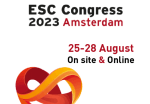The negative impact of mitral regurgitation (MR) on patient mortality, morbidity, and quality of life is widely recognized. However, only 15% of patients are referred for surgery due to their high surgical risk and low ejection fraction. Transcatheter edge-to-edge repair has become an important alternative for this group of patients. For subjects with degenerative MR,<a href="https://solaci.org/en/2023/10/31/tct-2023-clasp-iid-study-1-year-results-pascal-vs-mitraclip-for-degenerative-mitral-regurgitation/" title="Read more" >...</a>
Cause of Cardiac Death after TAVR at Present
Cardiac failure (CF) and sudden cardiac death (SCD) stand out as two of the main causes of death in patients with aortic stenosis. Although transcatheter aortic valve intervention has shown higher survival, these two continue to be the main conditions leading to patient death at followup. In its early days, TAVR also showed benefits, but<a href="https://solaci.org/en/2023/10/11/cause-of-cardiac-death-after-tavr-at-present/" title="Read more" >...</a>
Use of Drug-Coated Balloons in De Novo Lesions in Large Coronary Vessels
Drug-coated balloon (DCB) angioplasty is emerging as a novel treatment for coronary artery disease. Studies evaluating this strategy have demonstrated clinically non-inferior outcomes compared with those of drug-eluting stent (DES) implantation in patients with in-stent restenosis and de novo disease in small vessels. However, evidence for the use of DCBs in large coronary vessels is<a href="https://solaci.org/en/2023/09/28/use-of-drug-coated-balloons-in-de-novo-lesions-in-large-coronary-vessels/" title="Read more" >...</a>
Coronary Artery Calcium on Non–ECG-Gated Chest CTs: Mere Finding or Therapeutic Opportunity?
CAD related acute phenomena often present as a consequence of poor risk factor monitoring over time. Early detection of these patients, especially high risk patients, has significantly contributed to reducing morbimortality over time. Coronary artery calcification (CAC) is considered a measure of atherosclerosis burden in and might be present in asymptomatic individuals. Most centers do<a href="https://solaci.org/en/2023/09/26/coronary-artery-calcium-on-non-ecg-gated-chest-cts-mere-finding-or-therapeutic-opportunity/" title="Read more" >...</a>
Substudy TALOS AMI: from Ticagrelor to Clopidogrel in Patients with High Risk of Bleeding and AMI
The preference for the use of potent P2Y12 inhibitors such as ticagrelor and prasugrel in patients with high risk of acute myocardial infarction (AMI) undergoing percutaneous coronary intervention (PCI) is based on randomized studies and current guideline recommendations. However, clopidogrel is still recommended for patients at high risk of bleeding. Several strategies have been looked<a href="https://solaci.org/en/2023/09/20/substudy-talos-ami-from-ticagrelor-to-clopidogrel-in-patients-with-high-risk-of-bleeding-and-ami/" title="Read more" >...</a>
AMI and Multivessel Disease: Can We Perform a Single Procedure?
Percutaneous coronary intervention (PCI) is considered the treatment of choice in ST-segment elevation myocardial infarction (STEMI). However, it is widely acknowledged that, in many cases, there are significant lesions in other coronary arteries. Previous randomized studies have shown that complete revascularization in a second procedure is more beneficial than intervention only in the culprit artery.<a href="https://solaci.org/en/2023/09/19/ami-and-multivessel-disease-can-we-perform-a-single-procedure/" title="Read more" >...</a>
Is Complete Revascularization Really Necessary after AMI in the Elderly?
The population over 75 is growing gradually, which entails an increase in acute myocardial infarction (AMI) in this group. As we all know, it is fairly common for AMI to present with multivessel disease. It has been shown that younger patients will benefit from complete revascularization vs. a simple resolution of the culprit vessel. However,<a href="https://solaci.org/en/2023/09/13/is-complete-revascularization-really-necessary-after-ami-in-the-elderly/" title="Read more" >...</a>
OCT-Guided PCTA: Does It Offer any Benefits?
For many years, percutaneous transluminal coronary angioplasty (PCTA) has expanded significantly worldwide. However, despite the demonstrated advantages of intravascular ultrasound (IVUS) in terms of minimal luminal area, reduced cardiovascular events, and restenosis, its use is not very common due to various reasons. On the other hand, optical coherence tomography (OCT) offers even higher resolution than<a href="https://solaci.org/en/2023/09/12/oct-guided-pcta-does-it-offer-any-benefits/" title="Read more" >...</a>
ESC 2023 | OCTIVUS TRIAL: Is OCT Superior?
Researchers conducted a multicenter randomized study involving 2008 patients undergoing coronary angioplasty (PCI). In this group, 1005 patients underwent a procedure guided by OCT, and 1003 patients by IVUS. The average age of participants was 65 years, 21% of subjects were women, and there were no significant differences between both groups. The primary endpoint was<a href="https://solaci.org/en/2023/09/01/esc-2023-octivus-trial-is-oct-superior/" title="Read more" >...</a>
ESC 2023 | Anticoagulation After Primary PCI in STEMI Patients
The empirical prescription of anticoagulants after percutaneous coronary intervention (PCI), also know as post-procedural anticoagulation (PPA), is nowadays a common practice that uses various types of medications. Despite studies like HORIZONS-AMI and EUROMAX, in which 41% of patients received PPA, and the CCC-ACS registry, where 75% of subjects received PPA after primary PCI, European and<a href="https://solaci.org/en/2023/08/30/esc-2023-anticoagulation-after-primary-pci-in-stemi-patients/" title="Read more" >...</a>








